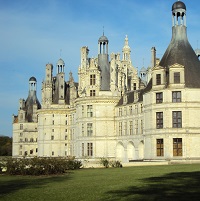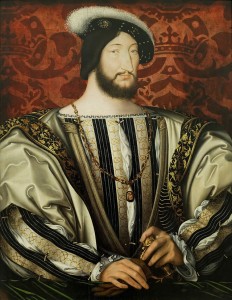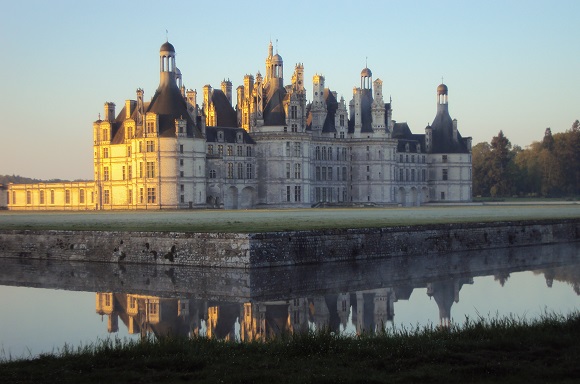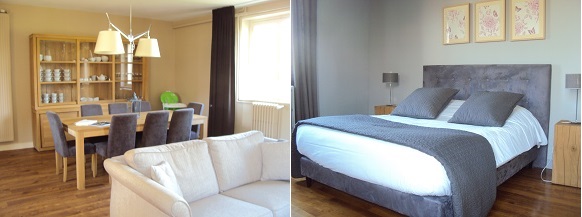
By Corinne LaBalme
When you can’t get any bigger, you just have to get better. Chambord’s 20-mile wall encloses a 426-room castle plus 13,443 acres of formal gardens and untrammeled forests where deer and wild boar roam, making it the largest enclosed park in Europe (and about the same square footage as the City of Paris). Right now, Chambord is in the midst of a massive development plan (€4.5 million invested in 2014) to make the castle more user-friendly and, ultimately, self-financing.
”Chambord is a conceptual castle,” explains Jean d’Haussenville, General Manager of the Domaine National de Chambord. Conceptual is an odd adjective choice for a monster stack of stone but it fits. François (Francis) I, the king most identified with the French Renaissance, commissioned the rural getaway in 1519, but Chambord failed as a functional hunting lodge. Its giant rooms, built around the outline of a Greek Cross much like the contemporary Saint Peter’s in Rome, resisted warmth in the frigid game season. Comfort-conscious François only spent 72 nights there during his 32-year reign.

Far more many days and nights are being devoted to celebrating this year the 500th anniversary of the Francois’s ascension to the throne. Francois inherited the crown upon the death of his childless cousin Louis XII in 1515 and ruled until his own death in 1547. Eleven major chateaux in the Loire Valley and many lesser chateaux and monuments, along with cities and towns throughout the area are promoting their kinship with that period. The purity of Chambord’s architecture as a reflection of the reign of Francois I makes it a major marker of the commemorative year.
Despite its vocation as a retreat after the hunt, Chambord’s frilly, massive silhouette is as much Beauty as Beast. The lacey turrets appear to pirouette in the wind and its slinky, Escher-esque double-helix stairwell is the White Album carved into stone. The jury’s still out on whether Leonardo designed the stairwell (building records went missing centuries ago) but even if he didn’t the château is infused with the artist’s charisma. ”Chambord,” insists d’Haussenville, ”is the Mona Lisa of architecture.”
Owned by the French state since 1930 and a UNESCO World Heritage Site since 1981, Chambord is currently 86% self-supporting with €16.5 million in annual operating expenses, already quite an achievement in French parlance. Its goal of 100% self-financing demands a push for 1 million visitors/year instead of the 770,000 at present. Chambord has recently pursued partnerships with royal sites of comparable candle-power (Beijing’s Summer Palace; Udaipur in Rajasthan) to build awareness around the world.
The château is also revamping its hotel and restaurant offers; opening new parts of the castle (like the 18th century kitchens in the West Tower next September); refurbishing the French formal gardens; restructuring the reception area; re-designing the façade lighting, and going into the wine business by planting vineyards this spring.
The vineyards will be growing Francois I’s musky fetish Romorantin grape, along with pinot noir. Romorantin, a white grape, was first introduced to the area (specifically to plant near the chateau at Romorantin 10 miles southeast of Chambord) by the king at about the time he ordered the construction of Chambord. The vines came from Burgundy, but the Cours-Cheverny wine-growing zone that one passes through when approaching Chambord from the west has for some time now been the only place in the world that that fully bases a wine on the grape.

How does all the improvement work impact on your personal visit to this iconic castle in the next few months? Rest assured: Some things won’t change. You will still have a multitude of tours (including wildlife jeep safaris in the nature reserve); equestrian shows; bike, golf cart and boat rentals; art shows; theater, and live concerts.
Events: The deer begin their theatrical mating rituals in the forest in mid-September, but that’s not the only thing to look forward to.
Molière’s Le Bourgeois Gentilhomme débuted at Chambord in 1670 in front of Louis XIV and the Court, and the Comédie Française production (with Christian Lacroix costumes) returns for two outdoor performances on May 22 and 23. National Archeology Days are June 19 to 21 and World Music Day (free admission) is celebrated on June 20. The Chambord Music Festival, July 3 to 18, kicks off with the Doulce Mémoire concert that recreates a Renaissance ball in honor of the 500 anniversary of François I’s coronation. Through August 30, the Chateau presents the playful contemporary paintings of Guillaume Bruère that turn a Francis Bacon-esque focus on François I and the French royal family.
On June 22, the castle debuts the HistoPad, a digital tour guide (in 12 languages) that provides remarkable value for its 8€ sticker price. (Only one needed per family.) With a swipe of the fingertip, you can see how each room was decorated in the past. “Enhanced reality” features also grant visitors x-ray vision to see through walls and into closets and coffers. There’s a kid’s treasure hunt included in the HistoPad tour that adults may try to hog. It’s very informative and lots of fun.

Lodging: If you want low price lodgings on the grounds, book a room before September 30 when the no-frills, two star Hotel Saint Michel, located a few feet from the castle’s doors, closes for an 18-month expansion/renovation. This genteel 19th century property has been ripe for a luxury makeover for decades, and it’s finally happening. Architect Jean-Michel Wilmotte (Paris’s Mandarin Oriental, Hotel Nell) has been tapped for the country chic re-do, so kiss those 75€ rooms (with no curtains) goodbye. Michelin-starred Chef Jean-Pierre Vigato (Apicius) will supervise the future dining options.
You can still stay on the Chambord grounds at a reasonable price with a little help from your friends. On the property there are two elegant self-catering cottages, inaugurated in 2013, that sleep eight and six, equipped with washing machines, dishwashers, TV, barbecue, wifi and free bikes. The tiny village that abuts the castle has souvenir stands and sandwich shops.
Getting There: Chambord is a 2-hour drive south from Paris. The closest major town is Blois, 9 miles west. While it’s preferable to have your own wheels (car, van, motorcycle or bicycle) to combine a visit to Chambord with stops at other chateaux in the area, shuttles to Chambord from the Blois train station operate in summer and take 25 minutes. There is also bus service from April to August between the chateaux of Blois, Chambord, Cheverny and Beauregard. Bus information can be found here. From Paris, there are infrequent direct trains to Blois from the Austerlitz Station. They take 1:25. More frequent indirect trains take 2:00, arriving in Blois via Orleans (from Paris’s Austerlitz Station) or via Saint Pierre des Corps (from Paris’s Montparnasse Station).
Further information: For more information about Chambord, including opening times and entrance fees, see Chambord’s official website.
Corinne LaBalme, May 2015.
Also see our articles about the nearby chateaux of Cheverny, Beauregard and Blois.


